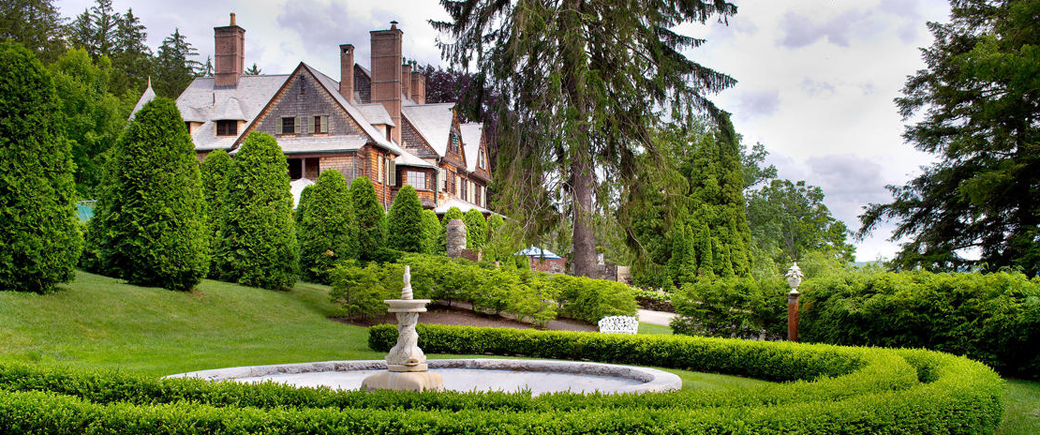Gardens of Naumkeag
Horticulturist Catherine Martini was a little bit star-struck when she first visited Naumkeag, a historic site that is now a public museum operated by the Trustees of Reservations.
“I had studied Naumkeag in school when I took a course in landscape design in art,” said Martini. “I was familiar with the gardens before I came here but seeing them in real life was like meeting a famous person. I was overjoyed.”
Martini, who has led the maintenance of Naumkeag’s grounds for the past 18 months, admired all the changes made over the years to the estate’s gardens and its state-of-the-art greenhouse. “I was completely in love,” she reported.
She describes the grounds around the classic house as “transitional.”
“It definitely has one foot in classical garden design and one foot in what we think of as modern. In between, it is completely fun to be in and fun to study. It’s constantly evolving.”
Naumkeag found its origins in the dream of Joseph and Caroline Choate. Choate, a leading American lawyer and diplomat in the 19th century, had summered in Stockbridge with his family since the 1870s. Like so many others who until this day have fallen under the spell of the Berkshires in summer, they decided to build a summer retreat there. In 1884, Choate sought the advice of his friend, Charles McKim of the architectural firm McKim, Mead & White. The result was Naumkeag, a 44-room “Berkshire Cottage” with commanding views of the Housatonic River Valley.
It became their home-base from which to mix with the elite of the Gilded Age, but, unlike other Berkshire estates, Naumkeag was not a showplace open only for six weeks a year. It was also a beloved home that the family used from April to November.
“Mc Kim, Mead & White built the house and did the rudimentary landscape design,” said Martini. “Caroline Choate did some of the garden design. She created the linden tree allee and, under her guidance, the evergreen garden took shape. But the estate was more focused on agriculture at that time. They grew the food for the house and for their city home.”
Joseph Choate died in 1917, and his daughter, Mable, inherited the property in 1929. It was under her ownership, with guidance from landscape architect Fletcher Steele, that the grounds were refined.
“When Mable Choate met Fletcher Steele, from then on, it was 30 years of renovating the gardens and doing interesting things,” said Martini. “Everything was shaped by their relationship.”
That relationship was long-lasting but never romantic, according to Martini. “Mable never married, and was much older than Fletcher Steele. She wore a ring that said she was wedded to art. She was into collecting things and traveling.”
Steele never married either but he had close relationships with his clients, most of whom were female. He and Caroline traveled together but most of those trips were to study gardens.
Today, the result of their collaboration creates an unforgettable experience for visitors to Naumkeag, where they can walk through the Afternoon Garden, the Tree Peony Terrace, the Rose Garden, the Evergreen Garden and the Chinese Garden.
Mabel Choate bequeathed Naumkeag in its entirety, including all of the household furnishings and fine art, to The Trustees of Reservations. Since the property’s opening in 1959, it has been a popular destination for area residents and visitors to the southern Berkshires. Approximately 11,000 people tour the house and experience the beauty and tranquility of the gardens each year.
With such a palette from which to work, what does Martini seek to bring to the estate?
“Because it’s a historic property, we can’t change too much,” she said, “but we are allowed to add some elements, especially below the blue steps and in the woods. We are able to add things that are not structural. I can look at it and say, ‘We need a touch of color here, or there.’ That’s where the tulips come in.”
In the fall of 2018, the crew planted 60,000 bulbs, mostly daffodils and some tulips, with the goal of them spreading into the apple orchard and along the woodland paths.
“The following year 20,000 tulips were switched out,” she said. “We have to plant the tulips every year because they are not quite as vigorous as daffodils. They are designer tulips and, after a certain time, they revert back to their original parentage. We have lots of peony tulips, parrot tulips and other designer tulips that you can’t trust to come back with the same color year after year.”
Whether enthusiastic visitors will get to see the tulips in all their glory this year is open to question. At present, the grounds are scheduled to open April 7th with the Tulip and Daffodil Festival planned for April 23rd-May 17th. Each weekend will offer a variety of pop-up activities on the grounds for visitors of all ages to enjoy. Admission to the festival includes self-guided access to the grounds and the first floor of the house.
Food and refreshments will be for sale and the annual Naumkeag plant sale will be happening throughout the Daffodil and Tulip Festival.
But COVID-19 could put awry the best laid plans. “I don’t know when we will open,” Martini confessed. “We’re going along, being really optimistic, but I fully anticipate we will comply with all the regulations. In the meantime, because a lot of our fundraising goes to help other Trustees’ properties that don’t generate income, we are selling our bouquets of daffodils and tulips. People will be able to drive up and take them home. And we’re already planting thousands of pumpkins for our fall activities.”
Any cancellations will be posted on Facebook.

